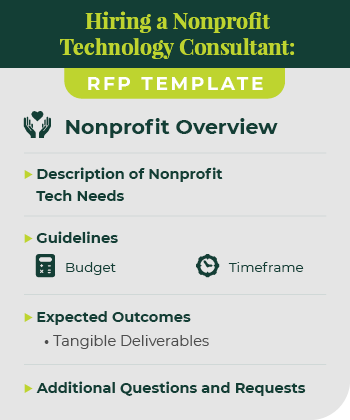
So, you’re thinking about starting a nonprofit website optimization project?
Whether you’ve been falling behind on regular website maintenance or you’ve simply outgrown your original build, taking the time to upgrade your nonprofit site is critical. It’s especially imperative if you want to increase your online fundraising and improve donor engagements.
Specifically, a dedicated website optimization project can ensure that all online processes are working correctly, raise your site’s search engine ranking, improve the user experience, and better position your organization for future engagements.
But what does this type of project entail? A website optimization project is more than slight tweaks to your content management system (CMS), updates to site content, and other essential website maintenance tasks. It can even involve an entire system rebuild to set your organization up for long-term growth and fundraising success.
While partnering with a dedicated technology consultant is your best bet, there are some simple steps that you can take now to get started. This guide will walk you through those steps and the benefits of working with a consultant for a more intensive plan:
- Complete a nonprofit website audit
- Identify current website gaps and opportunities
- Layout the steps for your website optimization plan
- Take a continuous improvement approach
- Partner with a nonprofit technology consultant
To begin, we recommend a nonprofit site audit.
1. Complete a nonprofit website audit
A nonprofit website audit is an in-depth review of how a website currently performs. The results of an audit are just what you need for a successful nonprofit digital transformation and site optimization project. It can reveal gaps in your content management system (CMS) and highlight specific areas in your nonprofit website that need improvement.
A comprehensive nonprofit site audit benefits from a technology consultant’s help, but your team can do a simple one on its own. To conduct your nonprofit website audit, you can:
- Scan your website for any technical problems. Watch out for big issues like a broken online donation tool and more minor fixes like your CMS or plugins/modules not being on the latest update.
- Identify search engine optimization (SEO) opportunities. SEO is the process of tweaking your website to rank higher in search engine results for certain keywords. Opportunities can include adding alternative text to images as well as using a clear heading structure.
- Check for broken features. If there are any links, forms, or files that don’t work on your website, this must be addressed and fixed quickly.
- Get rid of duplicated content. Do you have more than one page for the same type of content? Is your About Us information repeated in multiple places? Take the time to rid of any unnecessary duplicate content to minimize any confusion down the line.
- Assess page speed. Google recommends under three seconds for desktop devices.
- Ensure compliance with accessibility guidelines. Having an inaccessible website means you’re turning away potential supporters from engaging with your mission. Make sure your website follows the Web Content Accessibility Guidelines (WCAG).
In addition to taking the above basic steps, some free online tools can scan your site quickly and help with highlighting immediate issues. Check out these websites:
With a site audit done, you can now begin reviewing its results and making changes as needed.
2. Identify current website gaps and opportunities
Once you have the results from the website audit, you and your team should take the time to list the current gaps in your website and areas for opportunities. Did you find that your online donation page is taking a long time to load? Does your website have multiple pages for the same site content?
To continue this list, also look to your nonprofit constituent relationship management (CRM) system database. This software is where your nonprofit should host all of its data, including metrics on your website processes.
Take note if any engagements have fallen behind. Consider asking questions like:
- How is your overall online fundraising rate?
- How about your event and volunteer registrations?
- How many donors are opting-into regular email newsletters?
If you’ve noticed a lapse in conversions or a high bounce rate on a particular page, these are opportunities you can plan to address for your website optimization project.
3. Layout the steps for your website optimization plan
With your list of current website gaps and opportunities, it’s time to lay out the steps for your website optimization plan.
First, list the different action items by priority. Consider factors such as:
- Resources needed
- Number of staff members needed
- The time it will take to complete
- Value and impact it has for the nonprofit
How you prioritize each task will depend on your nonprofit’s unique needs. Do you have a tighter budget or were you cleared to spend a little more? Are you aiming to increase your online fundraising or drive volunteer recruitment?
These action items should not only describe the end goal itself, but the exact steps needed to get there. This includes a roadmap of the tools you need to invest in and how you’re going to use them.
Once your team lays out your action items, start assigning team members to each one. Consider the skills needed and assess whether or not contacting additional help, like a tech consultant, is your best bet.
Don’t forget to also determine the timeframe for the project, overall budget, and staff time needed.
4. Take a continuous improvement approach to website maintenance
While at times a website optimization project can take your website to the much-needed level, it’s not recommended to make this a regular occurrence. Not only is it time and budget exhaustive, it means that your website will go lengths of time not performing to the best of its ability.
We recommend taking a continuous improvement approach to website maintenance. This is the best way to ensure that your website fully functions and genuinely drives your nonprofit fundraising and engagement goals.
When you take the time to regularly check in on your website and make minor but frequent fixes, you receive benefits like:
- A fully working content management system with full functionality in plugins/modules and integrations with other nonprofit software
- Consistently updated website content to meet your current audience’s needs
- A secure site foundation prepared to support your nonprofit for long-term growth
Use your CRM database to keep track of online engagement data to ensure everything is working as planned. You can even set key performance indicators (KPIs) like online donation form bounce rate and recurring donor metrics to track specific website performance. If you notice that something is falling behind, you know it’s time to do some minor maintenance.
5. Partner with a nonprofit technology consultant
As mentioned earlier, many nonprofit leaders end up turning to technology consultants. If your tech audit results indicate a more hefty website optimization project than you planned, partnering with expert professionals is your best bet.
Nonprofit technology consultants can help with several essential tasks regarding your digital system and online engagements. Concerning a website optimization project, specialized consultants can aid with:
- Website building and development
- Site strategy development
- Website support
- Staff augmentation
The consultant that you partner with should not only do the above, but take the time to truly research your nonprofit goals, audience, and mission. This way, you know that the advice and help they’re providing will genuinely drive value for your organization.
To find the best nonprofit technology consultant, follow these steps:
- Review nonprofit needs to determine the specific website help you’re seeking.
- Meet with the nonprofit board and discuss guidelines regarding the partnership, including the time frame, budget, and current resources.
- Compile a list of consultants that you might reach out to who fit your organization’s values.
- Put together a request for proposal (RFP), providing consultants with the necessary information needed to pitch their plan to your organization. Use Kanopi’s RFP template as an example.
- Reach out to top candidates and ask for references to narrow down the selection.

You might think that this seems like more work than it’s worth, but finding the right tech consultant is more than just doing a simple Google search and reaching out to the first result.
The most valuable consultants work closely with your team to ensure that any changes or suggestions they make are positively impacting your nonprofit mission. Taking the time to follow the steps above will be your best bet.
Wrapping Up
A nonprofit website optimization project will benefit your organization, especially if you find your online fundraising and other engagements dropping off. With a more comprehensive look at your goals and an in-depth system rebuild, you can create the best nonprofit website and drive real value for your mission. Good luck!
____________________________________
Guest Post by Anne Stefanyk
As Founder and CEO of Kanopi Studios, Anne helps create clarity around project needs, and turns client conversations into actionable outcomes. She enjoys helping clients identify their problems, and then empowering the Kanopi team to execute great solutions.
Anne is an advocate for open source and co-organizes the Bay Area Drupal Camp. When she’s not contributing to the community or running her thoughtful web agency, she enjoys yoga, meditation, treehouses, dharma, cycling, paddle boarding, kayaking, and hanging with her nephew.